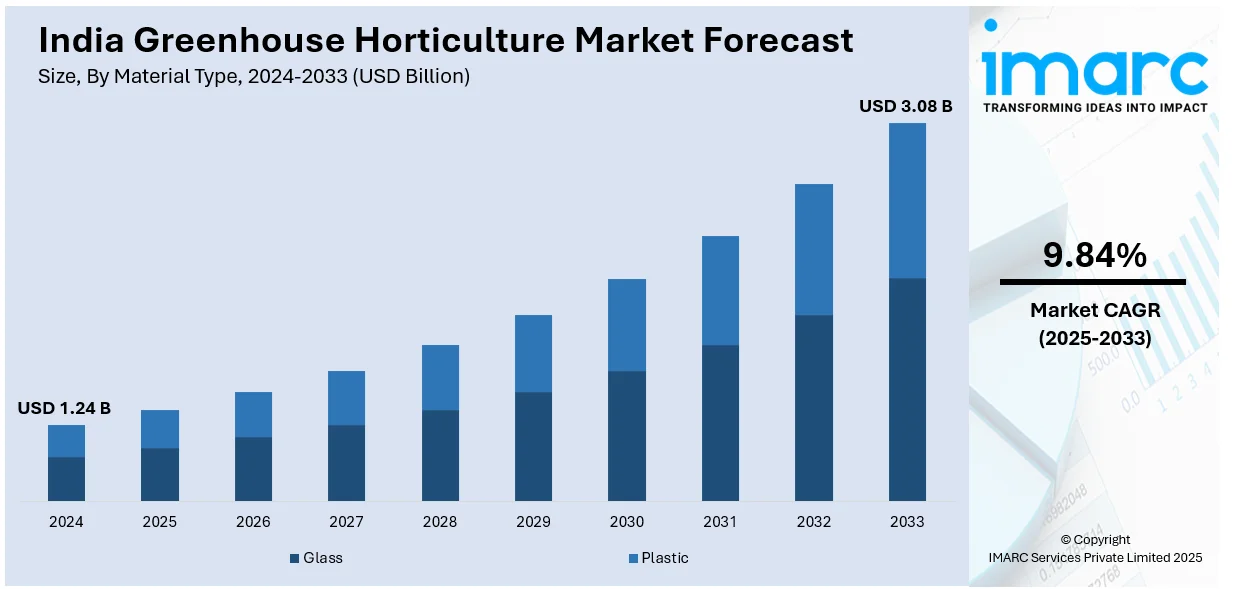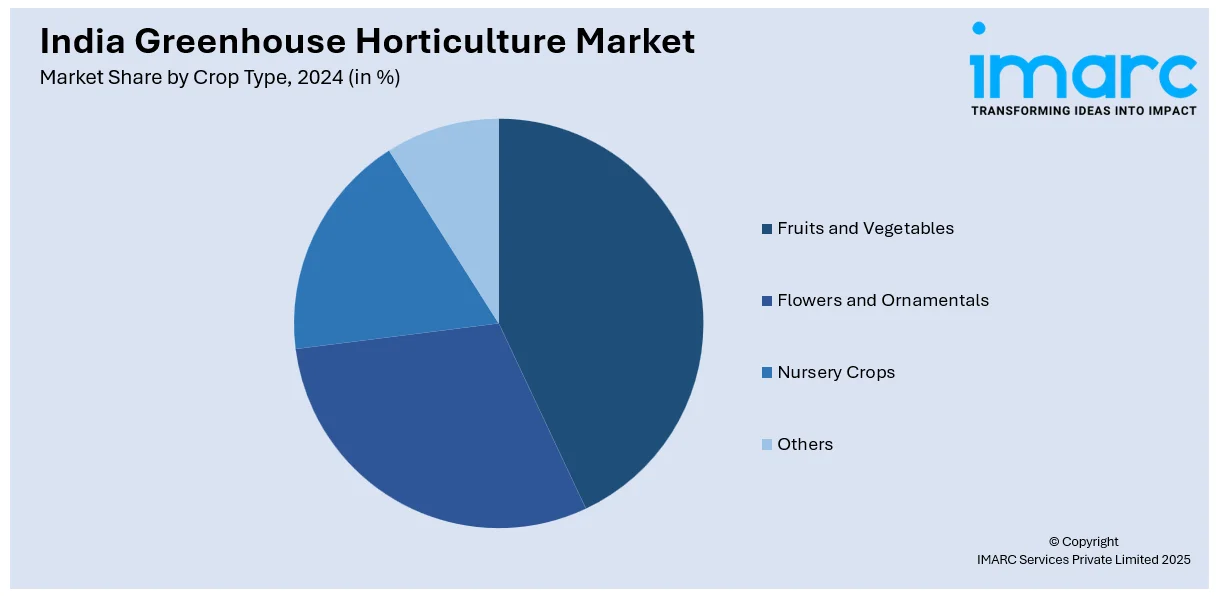
India Greenhouse Horticulture Market Size, Share, Trends and Forecast by Material Type, Crop Type, Technology, and Region, 2025-2033
India Greenhouse Horticulture Market Overview:
The India greenhouse horticulture market size reached USD 1.24 Billion in 2024. Looking forward, IMARC Group expects the market to reach USD 3.08 Billion by 2033, exhibiting a growth rate (CAGR) of 9.84% during 2025-2033. The rising demand for high-yield, quality crops, climate change impacts, government subsidies, advanced hydroponics and vertical farming, expanding urbanization, increasing investment in controlled-environment agriculture, growing floriculture exports, and adoption of automation, AI, and IoT-based greenhouse management systems are some of the factors propelling the growth of the market.
|
Report Attribute
|
Key Statistics
|
|---|---|
|
Base Year
|
2024
|
|
Forecast Years
|
2025-2033
|
|
Historical Years
|
2019-2024
|
| Market Size in 2024 | USD 1.24 Billion |
| Market Forecast in 2033 | USD 3.08 Billion |
| Market Growth Rate (2025-2033) | 9.84% |
India Greenhouse Horticulture Market Trends:
Strengthening Global Collaborations in Greenhouse Horticulture
International cooperation in greenhouse horticulture is expanding, with countries forming strategic partnerships to enhance sustainable food production. Advanced greenhouse technologies are gaining prominence, driven by knowledge exchange and industry collaborations. Events and conferences are fostering discussions on precision agriculture, automation, and climate-resilient cultivation methods. Investments in protected cultivation are increasing, improving crop yields, resource efficiency, and market sustainability. Cross-border initiatives are supporting skill development and research, enabling localized solutions for greenhouse farming. Governments and private players are actively engaging in long-term projects to modernize horticulture through technology-driven solutions. These efforts are addressing climate challenges, ensuring food security, and boosting economic opportunities in agriculture. The emphasis is on building resilient, high-yield greenhouse systems through global expertise and cooperation. For example, in November 2024, Dutch greenhouse experts visited India as part of the HortiRoad2India initiative to strengthen Indo-Dutch collaborations in sustainable horticulture. The delegation engaged in discussions at the Krishi Bharat Conference in Lucknow and events in Chennai and Hyderabad, focusing on advanced greenhouse technologies and sustainable food production solutions. The visit aimed to support India’s growing greenhouse horticulture market through knowledge exchange and long-term partnerships.

To get more information on this market, Request Sample
Advancing Protected Cultivation for Sustainable Horticulture
India is increasingly adopting protected cultivation techniques to enhance crop productivity, quality, and sustainability. Government-backed initiatives are driving investments in greenhouse structures, enabling year-round cultivation and reducing dependency on traditional farming conditions. Controlled-environment agriculture is gaining momentum, integrating advanced horticulture technologies such as climate control, automation, and efficient irrigation systems. These developments are improving resource efficiency, minimizing weather-related risks, and boosting farmer incomes. With financial support and policy interventions, the expansion of greenhouse farming is accelerating, addressing food security concerns while promoting high-value crop production. The focus is on modernizing horticulture through technology-driven solutions, ensuring resilience against climate fluctuations, and fostering long-term agricultural sustainability. Investments in infrastructure and research are shaping the future of precision horticulture. For instance, in 2024, India's greenhouse horticulture sector expanded under the Mission for Integrated Development of Horticulture (MIDH). Since 2014-15, the initiative has facilitated protected cultivation across 2.51 lakh hectares with an investment of INR 2,963.91 Crore. This effort has improved productivity, crop quality, and farmer income through greenhouse structures and advanced horticulture technologies. The program continues to drive sustainable agricultural practices in controlled environments.
India Greenhouse Horticulture Market Segmentation:
IMARC Group provides an analysis of the key trends in each segment of the market, along with forecasts at the region/country level for 2025-2033. Our report has categorized the market based on material type, crop type, and technology.
Material Type Insights:
- Glass
- Plastic
The report has provided a detailed breakup and analysis of the market based on the material type. This includes glass and plastic.
Crop Type Insights:

- Fruits and Vegetables
- Flowers and Ornamentals
- Nursery Crops
- Others
The report has provided a detailed breakup and analysis of the market based on the crop type. This includes fruits and vegetables, flowers and ornamentals, nursery crops, and others.
Technology Insights:
- Heating System
- Cooling System
- Others
A detailed breakup and analysis of the market based on the technology have also been provided in the report. This includes heating system, cooling system, and others.
Regional Insights:
- North India
- South India
- East India
- West India
The report has also provided a comprehensive analysis of all the major regional markets, which include North India, South India, East India, and West India.
Competitive Landscape:
The market research report has also provided a comprehensive analysis of the competitive landscape. Competitive analysis such as market structure, key player positioning, top winning strategies, competitive dashboard, and company evaluation quadrant has been covered in the report. Also, detailed profiles of all major companies have been provided.
India Greenhouse Horticulture Market News:
- In March 2025, India and the Netherlands expanded their greenhouse horticulture collaboration through Centers of Excellence (CoEs) demonstrating Dutch technologies. The first CoE opened in Baramati, followed by centers in Bangalore and Talegaon, focusing on improving yields while minimizing resource use. A CoE in Wayanad is under development for floriculture and vegetable cultivation, with staff trained in the Netherlands. These initiatives have strengthened sustainable greenhouse practices in India.
- In May 2023, the International Institute of Information Technology Bangalore (IIIT-B) and the Indian Institute of Horticultural Research (IIHR) collaborated to develop an automated greenhouse system for precision agriculture. This initiative aimed to enhance efficiency in greenhouse horticulture by integrating advanced automation technologies, optimizing resource use, and improving crop yields. The project contributed to the advancement of controlled-environment farming in India, supporting sustainable agricultural practices.
India Greenhouse Horticulture Market Report Coverage:
| Report Features | Details |
|---|---|
| Base Year of the Analysis | 2024 |
| Historical Period | 2019-2024 |
| Forecast Period | 2025-2033 |
| Units | Billion USD |
| Scope of the Report |
Exploration of Historical Trends and Market Outlook, Industry Catalysts and Challenges, Segment-Wise Historical and Future Market Assessment:
|
| Material Types Covered | Glass, Plastic |
| Crop Types Covered | Fruits and Vegetables, Flowers and Ornamentals, Nursery Crops, Others |
| Technologies Covered | Heating System, Cooling System, Others |
| Regions Covered | North India, South India, East India, West India |
| Customization Scope | 10% Free Customization |
| Post-Sale Analyst Support | 10-12 Weeks |
| Delivery Format | PDF and Excel through Email (We can also provide the editable version of the report in PPT/Word format on special request) |
Key Questions Answered in This Report:
- How has the India greenhouse horticulture market performed so far and how will it perform in the coming years?
- What is the breakup of the India greenhouse horticulture market on the basis of material type?
- What is the breakup of the India greenhouse horticulture market on the basis of crop type?
- What is the breakup of the India greenhouse horticulture market on the basis of technology?
- What are the various stages in the value chain of the India greenhouse horticulture market?
- What are the key driving factors and challenges in the India greenhouse horticulture market?
- What is the structure of the India greenhouse horticulture market and who are the key players?
- What is the degree of competition in the India greenhouse horticulture market?
Key Benefits for Stakeholders:
- IMARC’s industry report offers a comprehensive quantitative analysis of various market segments, historical and current market trends, market forecasts, and dynamics of the India greenhouse horticulture market from 2019-2033.
- The research report provides the latest information on the market drivers, challenges, and opportunities in the India greenhouse horticulture market.
- Porter's five forces analysis assist stakeholders in assessing the impact of new entrants, competitive rivalry, supplier power, buyer power, and the threat of substitution. It helps stakeholders to analyze the level of competition within the India greenhouse horticulture industry and its attractiveness.
- Competitive landscape allows stakeholders to understand their competitive environment and provides an insight into the current positions of key players in the market.
Need more help?
- Speak to our experienced analysts for insights on the current market scenarios.
- Include additional segments and countries to customize the report as per your requirement.
- Gain an unparalleled competitive advantage in your domain by understanding how to utilize the report and positively impacting your operations and revenue.
- For further assistance, please connect with our analysts.
 Request Customization
Request Customization
 Speak to an Analyst
Speak to an Analyst
 Request Brochure
Request Brochure
 Inquire Before Buying
Inquire Before Buying




.webp)




.webp)












